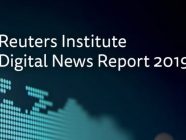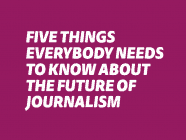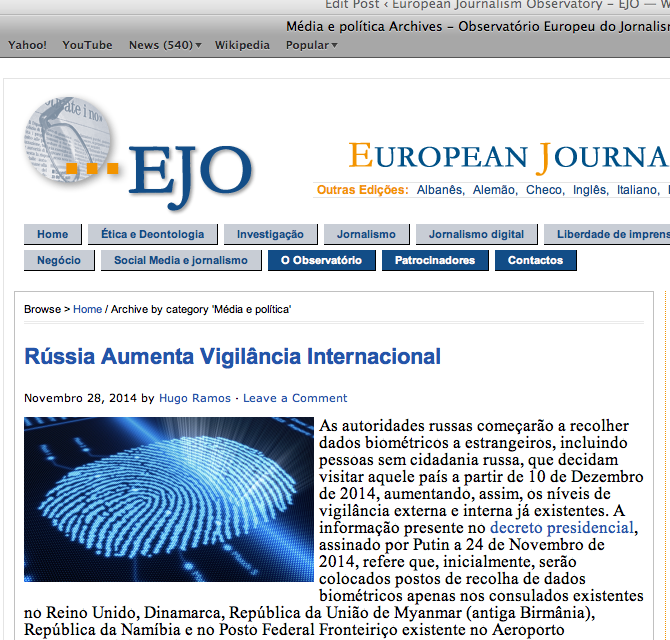Publishers see the rise of fake news as a chance for quality journalism to stand out, even as they worry about the increasing power of big tech platforms, and about their own commercial prospects. Going into 2017, they also see opportunities in video, chat bots and voice-activated assistants, according to a new survey of almost 150 CEOs, editors and digital leaders from 24 different countries. The survey is part of the Reuters Institute’s annual predictions report, launched today.
Over two-thirds (70%) of respondents to the survey say they think their position will be strengthened by recent controversies over fake news. Publishers hope that high quality reliable news will be needed more than ever in a world awash with misinformation, but some fear that the public’s trust in media could cause people to turn away from news altogether.
Counter fake news with quality journalism
Many publishers believe the best way to counter fake and poor quality news is to improve the quality of their own journalism. Kevin O’Sullivan, Editor of the Irish Times, says quality news media should be “more assertive about their journalism and how they do it; in reporting without fear or favour … articulating the values that support this journalism”. A digital-born publisher argues for a more open model: “News publishers can’t afford to retreat behind paywalls: we need to be out there, in people’s newsfeeds, challenging the lies at scale, treating disinformation on social media platforms as an urgent frontline beat.”
Publishers are already looking to improve fact checking. The Washington Post is trialling a new browser extension that automatically checks Donald Trump’s tweets. By the end of the year there are likely to be hundreds of browser extensions and message bots offering fact checking services.
The role and influence of platforms
A key question for 2017 is how the already tense relationship between publishers and platforms will develop. In our survey almost half (46%) said they were more worried about the role and influence of platforms compared with last year. Fewer than one in ten (9%) were less worried. As one UK digital leader put it:
“The news industry is starting to wise up to the fact that it has been thoughtlessly making Facebook and the other platforms better, to its own detriment. It’s time for these relationships to be reset.”
The biggest tension lies around whether publishers are getting a fair reward for the content that they produce. While many news organisations are making layoffs, Facebook and Google are thriving on their share of advertising revenue. In 2017 we can expect a number of publishers to try to further address the asynchronous relationship with platforms. One Nordic publisher, Schibsted, has already started to build its own platforms for content and advertising to compete with Facebook. Report author, Nic Newman, suggests that “we are also likely to see pressure on platforms to increase the amount they pay for content and more talk about government regulation too”.
Focus on paid content
The urgent challenge – mentioned by almost all print publishers – is to find new digital revenues to replace falling print advertising. A third (33%) of digital leaders say they are more worried about financial sustainability than this time last year. Only 8% said they were less worried.
Publishers are trying to work out how they can make money as we move from websites to smartphone apps and social platforms. One UK-based CEO sees the key task as “building out new diversified revenue streams beyond digital display advertising” while a senior digital editor at a leading French publisher outlines three challenges:
“Shifting our ad model from display to native, convincing more readers to subscribe and learning to deal with platforms in a smart way”
These priorities are mirrored in the survey data where we find digital leaders planning to focus more on direct reader payment (45%) and membership (14%), away from display advertising and towards sponsored content whether through text or video.
Which digital funding streams will you be focussing on MOST in 2017?
 Video is set to be a key priority in 2017 with 89% of publishers planning to invest in social video and 80% in live video on Facebook, Twitter and YouTube. Almost four in ten (38%) are planning some experimentation with Virtual Reality (VR) in 2017, despite production being both expensive and difficult.
Video is set to be a key priority in 2017 with 89% of publishers planning to invest in social video and 80% in live video on Facebook, Twitter and YouTube. Almost four in ten (38%) are planning some experimentation with Virtual Reality (VR) in 2017, despite production being both expensive and difficult.
In a bid to create more loyal readers, media companies will also be undertaking new initiatives this year in data, segmentation and recommendation (61%) along with registration and sign-in drives (52%). The BBC is planning to introduce mandatory sign up for BBC iPlayer by the summer, which will automatically identify news and sport users. This will allow personalisation to improve relevance of content, along with notifications to bring users back more regularly and (for commercial players) drive membership and subscription. Over two thirds of publishers (69%) said they would be investing more in mobile alerts and 38% in email.
Editors’ Notes
About the Reuters Institute for the Study of Journalism
The Thomson Reuters Foundation is the core funder of the Reuters Institute, based in the Department of Politics and International Relations at the University of Oxford. The European Journalism Observatory is an RISJ partner.
About the author
Nic Newman is a journalist and digital strategist who played a key role in shaping the BBC’s internet services over more than a decade. Nic is currently a Research Associate at the Reuters Institute for the Study of Journalism where he writes about changing audience behaviour and the impact of technology. He is the lead author of the Reuters Institute Digital News Report (2012–16) and the Reuters Institute Journalism Trends and Predictions (2016). He also co-authored The Future of Online Video Report (2016).
Survey Methodology
143 people completed a closed survey in December 2016. Participants were selected because they held senior positions (editorial, commercial or product) in traditional or digital born publishing companies and were responsible for aspects of digital strategy. Job titles included Editor in Chief, CEO, Head of Digital, Chief Product Officer, Director of Video etc. Over half of the participants were from organisations with a print background (51%), around a third (34%) represented commercial or public service broadcasters, one in ten came from digital born media (11%) and a further 5% from B2B companies or news agencies. 24 countries were represented in the survey including the US, Australia, New Zealand, Korea and Japan but the majority (90%) came from European countries such as the UK, France, Germany, Austria, Italy, Finland and Spain. Participants filled out an online survey with specific questions around strategic digital intent in 2016. Around 95% answered most questions although the response rates varied between different questions. Additional open-ended questions were asked around key challenges and opportunities. Around 50% contributed comments and ideas in these areas.
pic credit: JSawkins Flickr CC licence
Tags: 2017, digital news, Nic Newman, predictions, publishers, Reuters Institute for the Study of Journalism














































